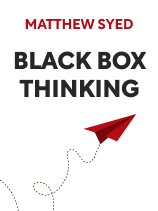

This article is an excerpt from the Shortform book guide to "Black Box Thinking" by Matthew Syed. Shortform has the world's best summaries and analyses of books you should be reading.
Like this article? Sign up for a free trial here .
Do you know how to create a learning management system? Why would you want to create one?
Black Box Thinking argues that learning systems help a workplace to advance while a failure-averse system stunts growth. A learning management system is an organizational system that allows people to learn from their mistakes.
Keep reading to learn how to create a learning management system in just four steps.
Create a Learning Management System in 4 Steps
Are you ready to find out how to create a learning management system? After changing an organization’s culture, the next step in discovering how to create a learning management system is to change its systems. (Shortform note: Syed offers loose ideas more than practical wisdom. To supplement his thinking, we’ve interspersed commentary from The Fifth Discipline by Peter Senge, which discusses learning organizations.) Syed offers the following four ideas:
Step 1: Create Better Feedback Mechanisms
This is an important step in finding out how to create a learning management system. Feedback enables learning—you can’t see your mistakes without it. Since many organizations lack a built-in error signal, a key step is to create a mechanism to capture that feedback. For example, local governments could hold weekly feedback sessions with community members to learn how they’re doing on a week-to-week basis.
The tighter the coupling between action and feedback, the faster you can learn. This is because more signals mean more to learn from. For example, a mayor who coasts through his term won’t learn much—his lack of action precludes the gathering of feedback, and so prevents learning.
(Shortform note: An easy way to gather feedback is to record a video of what you’re doing. Josh Waitzkin writes in The Art of Learning that he recorded his tai chi practice sessions to identify mistakes and refine his form. Similarly, imagine recording a video of a community meeting, then holding a retrospective with key players to analyze how things went and what you could do better. That way, you can tangibly identify mistakes—for example, maybe your dialogues are dominated by the most extroverted community members—and fix them. In this case, you might explore new conversational modalities that hold space for quieter individuals to express their perspectives.)
Step 2: Prototype Adaptive Systems
To select the best learning systems, Syed suggests creating numerous systems and pitting them against each other. This system of systems enables the best individual systems to rise to the top. Below is an example of prototyping when discovering how to create a learning management system.
Syed describes that the market system mimics natural evolution: Individual businesses compete against each other, and the best survive while the rest “die” (go bankrupt). Those that survive best fit the demands of the modern world. Today, business fitness means agility—and in fact, lean startups (à la the MVP from Part 2) outcompete companies using slower, older ways of doing business. So their style of system is evolutionarily superior in the market environment.
(Shortform note: In 1968, geneticist Kimura Motō proposed his “neutral theory” of gene variation, arguing that biodiversity comes not just from “survival of the fittest,” but also from luck. Chance events can kill off some genes while others survive, such that luck partially determines which variants exist today. Similarly, random chance plays a role in business competition: While “fitness” (such as business acumen, agility, and experience) plays a role, any business can experience significant random events. For example, a key leader could come down sick during an important deal. Or a founder could reach out to a potential investor on a great day, catching that investor in a good mood that helps them work out a great collaboration—largely by chance.)
Step 3: Use Pilot Programs
This is the third step in finding out how to create a learning management system. In politics, Syed suggests running pilot programs—small-scale tests of policy changes or business ideas that allow you to get feedback safely and inexpensively. Be sure to set up pilots that mimic real-world conditions. By staffing them with a mix of experienced and inexperienced employees, you’ll get a sense for how an actual team would perform under your program.. Avoid setting pilots up for success by staffing them with only your best people, tools, and facilities. If you guarantee success, you won’t learn anything.
(Shortform note: In 2019, the US Congress passed the Foundations for Evidence-Based Policymaking Act, which stipulates that lawmakers and federal agencies must begin developing statistical evidence to support policies. While evidence-based pilots were once thought to be too expensive or time-consuming, the rise of agile methods in software engineering and in the broader business world has shifted that attitude. Now, numerous federal agencies, from the FDA to the Department of Labor, have begun running pilots, much like Syed suggests.)
Step 4: Use “Pre-Mortems” to Strategize
This is the final step in discovering how to create a learning management system. Before launching projects, Syed suggests running a “pre-mortem,” which improves outcomes by helping you discover the flaws in a plan before implementing it.
To perform a pre-mortem, ask your team to imagine that the plan has failed completely—your campaign crashed and burned, your product flopped, and so on. Then, work backward by asking what went wrong. Typically, discussing these failure modes enables the team to improve its plan and better avoid failure—in fact, research holds that this predicts the reasons for failure versus success with 30% greater accuracy.(Shortform note: In The Obstacle Is The Way, Ryan Holiday suggests that pre-mortems are also a useful tool for personal growth. Hardships, he says, are inevitable. By expecting that bad things will happen sooner or later, we better prepare ourselves for them. And by actively anticipating what could go wrong (such as with your workday, a date, or a difficult conversation) you improve your chances of success. Specifically, he suggests thinking up as many possibilities for failure as you can, and then creating a contingency plan for each.)

———End of Preview———
Like what you just read? Read the rest of the world's best book summary and analysis of Matthew Syed's "Black Box Thinking" at Shortform .
Here's what you'll find in our full Black Box Thinking summary :
- How an organization’s culture and systems either promote or prevent learning
- The steps for learning from failure in our complex world
- How to shift mindsets around failure to promote a learning-oriented institution






